OR/15/034 Applications
| Alan W P Thomson (editor), Ciarán Beggan, Ellen Clarke, Simon Flower, Brian Hamilton, Gemma Kelly, Sarah Reay, Tony Swan, Alan Thomson, Chris Turbitt (contributors). 2015. Geomagnetism review 2014. British Geological Survey Internal Report, OR/15/034. |
Space Weather Applications and Services
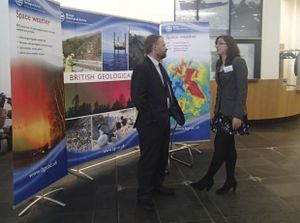
Research into space weather and the related geomagnetic hazard finds application in a number of data products and services to academic and commercial users. In 2014 BGS was involved in a number of projects that highlighted the importance of our space weather research and services in hazard assessment for technological infrastructure.
The Geomagnetism team continues to work closely with a number of partners with an interest in Space Weather.
In March the Geomagnetism team hosted the first Space Weather Research Network (SEREN) workshop on geomagnetically induced currents. The aim of the STFC-funded SEREN project is to develop research partnerships, particularly on space weather impacts on ground-based technologies. The event was well attended, with representatives from the Cabinet Office, National Grid, Scottish Power, Atkins, Met Office, Natural Resources Canada, UK space agency and several UK universities all in attendance.
The workshop provided a forum for discussions about how best to move forward in improving our ability to assess and mitigate geomagnetically induced currents in power grids, and in providing nowcasting and forecasting tools to support this. It was also a good opportunity to gather perspectives from both users of space weather services and the research community.
In October, representatives from BGS attended the launch of the new Met Office Space Weather Operations Centre (MOSWOC). This marked the official start of their 24/7 space weather operations.
Collaboration with the Met Office continues to grow stronger. Daily teleconferences to discuss the space weather forecast help improve geomagnetic activity forecasts by making use of joint expertise. Continued maintenance and development of the data BGS provides to the Met Office also helps to ensure alerts and warnings are timely and correct.
Members of the Geomagnetism team also participated in the UK ‘Space Weather Public Dialogue’. This is a project aimed at building a better understanding of how members of the public understand the risk of space weather. The findings are being used to guide future government policy and communications on space weather. Find more information about the project at talkspaceweather.com
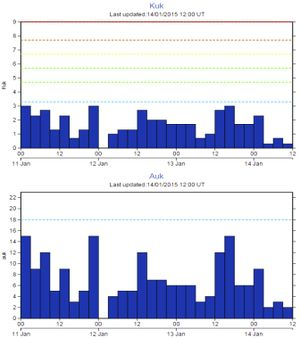
Highlights of other activities
- Continued maintenance and development of the MAGIC (‘Monitoring and Analysis of GIC’) web tool for National Grid.
- 3 posters, an invited talk and a live space weather forecast presented by BGS staff at the 11th European Space Weather Week in Liege, Belgium.
- Three posters on recent BGS space weather research at the ‘Hot Spring MIST’ meeting in Bath.
- Sensitivity analysis of our UK GIC model with respect to changes in both the external magnetic field strength and direction and the Earth conductivity model. The location and magnitude of the geomagnetic electrojet is found to be the primary control on the size of GIC, although conductivity can be locally important.
- Analysis of coronal mass ejection parameters available in near real-time, in relation to geomagnetic storm magnitude, to produce ‘look-up’ tables for use in our operational space weather forecasting.
- A successful application for funding to STFC to measure the effects of space weather in the UK by building and using a network of ‘school magnetometers’.
- Launch of a new aurora mapping tool (www.bgs.ac.uk/geosocial) using social media to record sightings of the northern lights in the UK.
- Manning a space weather stand at the ‘Science Uncovered’ event at the Natural History Museum.
- An Earth System science spring school talk about space weather.
- Continued data exchange with the US National Oceanic and Atmospheric Administration’s Space Weather Prediction Centre (SWPC), in Colorado.
- Attendance and presentation at the final meeting of the EURISGIC (‘European Risk from Geomagnetically Induced Currents’) FP7 project in Helsinki, January.
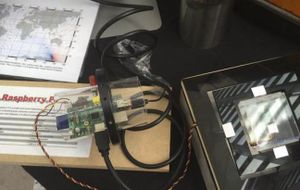
Directional drilling at high geomagnetic latitudes
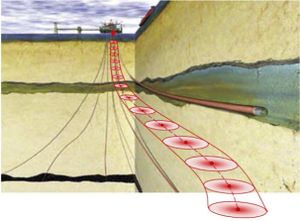
The IIFR service uses geomagnetic observatories to improve the accuracy of geomagnetic referencing in measurement while drilling surveys. Indeed, as drilling gradually creeps northwards and typical time variations in the magnetic field caused by solar activity become greater, the need for IIFR and suitably located high-standard observatories is likely to rise. Attaining the desired accuracy for extended-reach drilling is a far greater challenge at high geomagnetic latitudes than elsewhere in the world. The use of observatories will certainly help but the question is: what is the critical distance from the drill site within which an observatory’s data still reduces uncertainty.
The Earth’s magnetic field is a vital directional reference when drilling for oil and gas around the world. Using a combination of magnetic sensors and accelerometers in the bottom hole assembly, together with accurate estimates of the geomagnetic field, directional drillers are able to safely direct wells towards intended geological targets.
In 1994 BGS along with industry partners developed a method for improving the accuracy of geomagnetic referencing for directional drilling operations by including both the local spatial and time varying components of the Earth’s magnetic field. This technique, known as Interpolation In- Field Referencing, or IIFR, has been used extensively ever since. With increased drilling activity at higher geomagnetic latitudes – in locations such as Alaska, Canada and the Barents Sea — IIFR is now more important than ever.
At such locations maintaining the desired accuracies in extended-reach drilling can be a much greater challenge than elsewhere in the world and for MWD operations, where gyroscopic methods may not be an option, the use of geomagnetic referencing is essential. In order to reach challenging oil and gas targets and to avoid well collisions it is important to estimate the uncertainties as accurately as possible, as well as to reduce these uncertainties where feasible.
Disturbances in the Earth’s magnetic field caused by electrical currents flowing in the ionosphere and magnetosphere can significantly perturb the strength and direction of the magnetic field measured down hole. During storms, variations in declination of several degrees over a short period of time can occur and it is well established that these effects are on average greater at higher magnetic latitudes such as those nearer the auroral zone. Even during magnetically quiet times, variations can exceed desired thresholds for MWD at these locations.

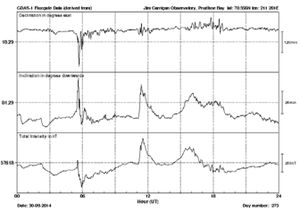
The IIFR solution has been successfully employed at a few high latitude locations with the disturbance field variations accounted for at the drill site by applying real-time magnetic field measurements made at a nearby magnetic observatory. However many drilling campaigns are further off-shore or in remote locations where it is not possible (or certainly not straight forward) to measure the strength and direction of the Earth’s magnetic field near the drilling location, to the required accuracy and time resolution.
In order to quantify how the uncertainties change with distance between observatory and drill site a comprehensive study using observatories at high geomagnetic latitude locations (60–75°) is on-going and this will be completed in 2015.
Pairs of sites are used to extrapolate the disturbance field and determine the critical observatory distance (COD), beyond which the accuracy is no longer improved by adding the time-varying values to models. The COD depends on the geomagnetic latitude of and the direction to the observatory(s).
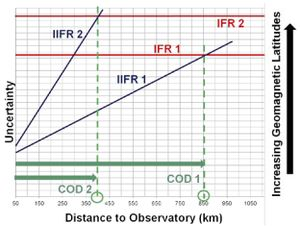
With >3000 years of station pairs, a robust statistical analysis is possible. The inclusion of data over periods of more than 11 years, will also provide the seasonal and solar cycle variations in the COD.